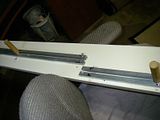
Since it was requested and I feel it is a great request, I will submit photos of my furling board.
I use a 1" X 8" X 8' board that has been cut in half so that it is easy to store in my fly tying room closet plus easier to haul in a vehicle. I have 2 alum. channels fastened to the end of one half so that the other half can be slid into the channels and then locked together with a double-hung window latch as in this picture:

So that I can easily make different lengths of furled leaders, I have installed alum. channels on my board marked where the pegs need to be for the different lengths. This would have been a lot easier to do if I owned a router, but, I did not, so I used the 1/2" channels screwed down to the board and spaced so the head of a carriage bolt could be slid up and down the channels. The carriage bolts are fastened in the ends of the wooden dowels by a threaded insert in the dowel rod. To move the peg you just loosen the peg and slide it where you want it and tighten.

In this picture the 2 metal pieces at the left on the end of the board is the starting and ending points for the lay out. The peg with the cup hook is the 10% reduction points for each furled leader. You just insert the peg in the corresponding hole based on what length furled leader you are making and my board will make a 4', 5', 6' and 7' furled leader.

I only use either fluorocarbon or mono for my use and have made a few thread leaders upon request. For twisting each leg to the 10% reduction peg, I use a cup hook locked in a Dremel Tool. I have discovered that I do not have to hang my leaders to allow them to furl. I decided that the only reason for the weight is to keep tension on each leg while they furl together so they do not kink up, so, I just rigged up a snap swivel on a wire inserted into a wooden peg for a handle and once each leg is twisted, I just hook the snap swivel onto the twisted leader at the tippet peg, pull back to maintain tension and slowly come forward to allow the legs to furl together. A drop of oil every once in a while on the snap swivel keeps everything in good working condition. I do this with thread and have had no problems with it furling together. The 2 legs twisted together is a lot of energy and they will furl.
I know there are better ways, but, this works for me and is rather simple which I like.
RonT - I have a question on the electric mixer. If you hook each leg of the leader onto the hooks on the mixer and turn it on won't the mixer be twisting each leg in opposite directions? I have always been taught to twist each leg in the same direction so they will furl together. Just curious and nothing more.....
Warren
Fly fishing and fly tying are two things that I do, and when I am doing them, they are the only 2 things I think about. They clear my mind.







 Reply With Quote
Reply With Quote